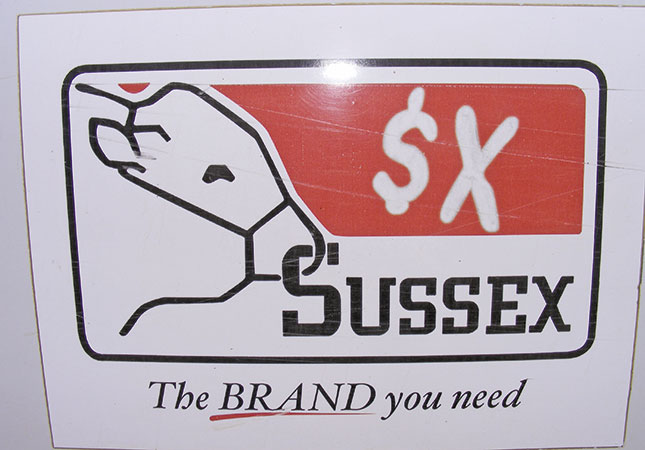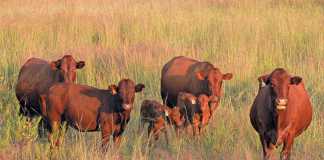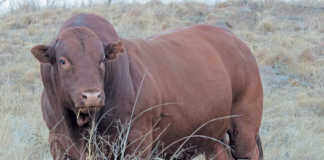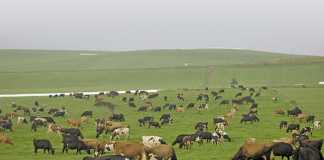
The Huntersvlei Sussex stud is part of the Rhys Evans Group near Viljoenskroon headed up by Anthony Evans. The 68-year-old stud has about 500 breeding cows. A commercial Sussex herd of 1 050 animals is run on two other farms. The management team at Huntersvlei has retained a balanced approach to breeding, despite selecting for the polled gene.
“We introduced the polled gene because of growing demand,” says Anthony. “Polled cattle are sought after now, as calves and cattlemen alike are spared the stressful dehorning process. Most feedlots are prepared to pay a premium for polled animals to prevent injury and bruising. You can do a lot of harm with horns in the feedlot and downgraded carcasses mean heavy penalties.”
Arno Cronje, general manager of the Rhys Evans Group, says the polled animals are in a closed herd as they are developing select polled Huntersvlei bloodlines. “We introduced the polled trait after the Sussex Cattle Breeders’ Society of South Africa imported polled genetics from Australia about 15 years ago,” he says. According to Arno, the Sussex Breeders’ Society imported fresh genetics in three bloodlines from Australia and made the semen available to Sussex breeders countrywide.
“At that stage, the polled factor was a bonus,” he says.
Anthony and Arno agree that during the last five or six years, polled genetics have been more in demand. “The commercial farmers are asking for polls and they’re starting to perform well at shows. A few years ago, we visited the UK looking for polled Sussex that would suit our conditions. We wanted to increase the size of the South African gene pool and introduce Sussex genetics with the polled trait.
Because of the cost and effort we incurred in travelling, we’ve kept our genetic material exclusive for a few years. Of course, once our clients start using bulls they’ve bought from us, we lose the exclusivity,” says Arno. He adds that Anthony visited a number of studs in the UK with the aim of bringing in three bloodlines. “We ended up importing two – Wellington from the Goldstone Stud and Captain from the Mayfield Stud. Our polled herd now consists of five genetic lines.”
Arno says that some farmers do not want polled cattle, as vague myths linger about the trait being linked to penis and sheath prolapse. The other problem is that imported animals have no South African EBVs, so their progeny initially show poor figures. “But we’re in the process of sorting out that problem, as our affiliated stud book has agreed to use UK figures so that progeny EBVs are a better reflection of real performance,” he explains.
The Huntersvlei herd has been around for 68 years and has well-adapted animals. Calves inherit a degree of environmental fitness from their mothers and grow out in the right conditions to adapt. “Huntersvlei has very good mother lines,” says Arno. “Our cows are highly suitable as breeding animals, with genetics capable of smoothing out possible weaknesses such as a lack of strength in milk production.”
Production and breeding
The English bloodlines will be available for the first time at the annual Huntersvlei Sussex production sale in August. At last year’s sale, polled bulls sold for prices well above the average. Dawie Albertyn, a Sussex breeder from Bredasdorp, bought two polled bulls for more than R60 000 each. The Huntersvlei team plans to use the polled gene test now available in New Zealand.
“We’ll test selected animals once we’re sure that the horn trait is not expressed,” says Arno. “DNA results that confirm homozygous dominance (both genes show polledness) will add value to the animal.” Polled or horned, Huntersvlei animals must comply with strict selection criteria. “More than 68 years of breeding and selection have ensured reliability and consistency,” explains Anthony. “Our bulls are tested under extensive veld conditions. We breed animals with width and muscling.”
According to him, Huntersvlei breeding values show exceptional maternal characteristics. A 50-year background of performance recording ensures meaningful reproduction values. “Introducing the polled gene means we’re keeping up with current market demand. Using the Sussex in a cross-breeding programme is a good way of getting polled animals onto the commercial market,” says Arno.
Some Huntersvlei clients farm in extensive areas such as the Kalahari and Botswana and may see their cattle only once a month. “A lot of these farmers don’t have a specific breeding season, and dehorning extensive herds with a year-round calving pattern is a serious management headache,” says Arno.
The Huntersvlei stud maintains a 97% calving rate, with calves averaging 39kg at birth and 274kg at weaning. The breeding season runs from November to January, with groups of 30 cows put to one bull. Heifers are bred from September to November for easier first-calver management and better reconception. Between 10% and 15% of Huntersvlei stud cows are artificially inseminated, mainly with semen from Australia and the UK.
Stud manager Dallas Phillips says that selection criteria and EBVs are strictly applied. “For nearly 70 years, Huntersvlei Sussex has been producing hardy, medium-framed, early-maturing beef animals with abundant milk. Exceptional milk production is a strong feature of the Sussex breed and we want to maintain the best genetics in our herd,” he explains.
According to Dallas, 55% of the bulls born in the Huntersvlei stud make it to the annual sale. They are put through a Phase D test after weaning, and then a veld-bull test with a Supermol supplement during summer. In preparation for the annual sale they get Voermol SB 100. “Once the bulls have been through the Phase D test and the veld test, at about 30 months, they’re ready for the production sale,” Dallas continues.
“Judges from the Sussex Cattle Breeders’ Society of South Africa screen all stud animals on conformation and EBVs. Bulls are fertility-tested and sheath-washed for trichomoniasis, and vibrio and pelvic measurements are carried out on heifers.” Anthony, who scoured the UK looking for good genetic material, says that polled genetics will become increasingly important in the beef industry for practical reasons.
“Huntersvlei Sussex is leading the field in breeding polled Sussex cattle. We plan to increase the percentage of polled animals in our herd, as we believe demand will rise,” he says.
Veld and fodder
The stud herd is run on one farm and the commercial herd is split between two other farms. Pasture and veld make up about 2 000ha and roughly 800ha of this is a Themeda/Digitaria mix.“We carry about 2,5 MLU/ ha on the pastures. In winter, when the veld dies back, we put cattle onto maize stover and supplement with appropriate licks.
“Home-grown hay and silage are also used during winter,” explains Arno. Grazing camps of between 10ha and 60ha are rotated according to the condition of the veld. Smuts finger grass and Eragrostis are planted to improve fodder flow during slump periods.
A phosphate lick in summer and a protein lick in winter is supplied to cows, first calvers and heifers.
Decades of service in a family business
Stability is a recurring theme at Huntersvlei. The organisation has a stable workforce, which provides the continuity so vital to a successful agricultural enterprise. Dallas has been working for the company for 30 years and Arno has been with the Rhys Evans Group for 22 years. “I can’t imagine being anwhere else,” says Arno.
There is continuity of ownership too. Anthony’s son, David, is the fourth-generation Evans in the business, which has been in the family for more than a hundred years.
Phone Anthony Evans on 056 343 3311 or Arno Cronje on 084 699 1086 or email [email protected].













